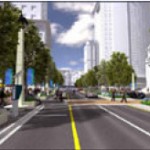Our past choices about where and how we grow have led to limited and unaffordable housing, and left too many of us dependent on driving for almost everything.
Smarter land use means more inclusive, vibrant, and sustainable communities: communities that are safe and convenient for walking and biking to daily needs – schools, stores, parks, and jobs; offer a diversity of housing options for people at different income levels; and are served by reliable, frequent public transit.
It’s good for our environment, good for people, and good for business.
Direct new homes and businesses to existing communities with access to transit
Providing more homes and businesses in existing communities with transit supports connected, economically thriving communities. It is also more sustainable and efficient than chasing sprawl development with new and costly infrastructure. Instead, focusing growth in already established communities allows us to welcome new neighbors and means private developers can contribute to modernizing aging infrastructure, like our schools, transit services, roads, sidewalks, and stormwater facilities.
Create compact, walkable, bike-friendly, mixed-use communities
We envision communities where each of us can conveniently meet our daily needs, and have more choices in how we get around. Walkable, bikeable, transit-oriented communities can provide easy access to jobs, services, retail, and community gathering spaces. This creates opportunities for connection and requires shorter and fewer car trips—reducing household transportation costs and greenhouse gas emissions.
Preserve rural farms, forests and natural areas
The smart growth approach to land use reduces pressure to convert farms and forests and natural areas to development – which is key in this era of climate change. Instead, smart growth focuses on turning existing and underutilized parking lots and commercial spaces into mixed-use, walkable neighborhoods with homes and businesses. Along with tools like agricultural zoning and conservation easements, this allows us to protect our farms, forests, natural areas, and drinking water supplies.
Latest Happenings
We would like to express our support for the White Flint Sector Plan and urge the Council and County Executive to support it too. We strongly support the County focusing growth here at a Metro station rather than new areas that require major new public infrastructure investments like the Gaithersburg West Plan, which we oppose in its current form. We need to make the distinction – we should focus growth around our Metro stations and revitalize major commercial corridors like Rockville Pike. Conversely, the great amount of development proposed in the Gaithersburg West Plan fosters sprawl, long distance commuting, increased traffic, air and water pollution. Overzoning Gaithersburg West undermines the redevelopment of Rockville Pike and Metro station areas – the very areas where we should be encouraging sustainable, transit-oriented development and great urban boulevards and streets.
We urge you to oppose the Gaithersburg West Plan. We believe that the major expansion in planned employment proposed in the Plan is detrimental to county residents and poses a serious threat to smart growth in the region. We urge the county to refocus efforts to ensure a quality growth plan for the White Flint Metro station area, and fostering employment growth at existing underutilized Metro stations and along transit corridors in down and east county locations. The Life Sciences Center (LSC) portions of the Gaithersburg West Plan proposes excessive density for the location–far from a Metro station, which will exacerbate the housing-jobs imbalance, and induce sprawl and unnecessary car traffic.

Learn about the necessary ingredients to successful neighborhood design.
We support the vision of this plan — “achieve a transit-oriented and pedestrian-friendly community that celebrates and builds on cultural diversity of the existing and future residents.” We are excited about the coming bus transit center and future Purple Line stations. We share the county’s aspiration for this plan to spark redevelopment and boost economic development on outdated automobile-oriented strip malls; building higher density, vibrant, mixed use places that are inviting for pedestrians. We agree with the plan’s emphasis on the need to improve connectivity and create a compact, walkable environment. We believe redevelopment of key commercial parcels around the planned transit stations offers great opportunity to foster an attractive walking environment, with new jobs, businesses and housing.
PBS’s Pulitzer-prize winner journalist Hedrick Smith exposes in his new Frontline documentary “Poisoned Waters” the damage being done to the nation’s delicate aquatic ecosystems like Puget Sound and the Chesapeake Bay. During his investigation, he finds that one of the major sources of the problem is our land use decisions

